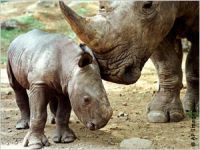CITES meeting: Humankind under the spotlight
More than being just another meeting of CITES (Convention on International Trade in Endangered Species of Wild Fauna and Flora), the UN-sponsored conference which opened on Sunday in Bangkok, Thailand provides a telling spotlight on Humankind, a chance to place a benchmark for posterity to judge us.

"I got rid of the dog because it didn't go with the sofa" is perhaps the epitome of callousness, expressed by a woman who took her dog for adoption after Christmas in the United Kingdom. While this example is atypical of people in general, it sums up the mindset of many who either do not care about the welfare of animals but also who make a profit trading in their ivory, their horns, their skins while driving species to the brink of extinction, and beyond.
The CITES Conference which started on Sunday in Thailand (and runs until March 14) will examine seventy proposals from fifty-five countries to amend the wildlife trading system, aiming to overhaul existing protocols. In the words of John E. Scanlon, Secretary-General of the Convention, "2013 will be of great significance to the future of many species of plants and animals".
CITES has 176 member states and regulates international trade in some 35,000 species of animals and plants, their products and derivatives. On the table in Bangkok is the issue of improving the conservation of marine and water species (Polar bears, sharks, freshwater turtles, frogs, crocodiles and ornamental and medicinal plants), the protection of species such as the vicuña, elephants and white rhinos, combating the illegal trade in ivory and rhinoceros horn, discussion on measures to improve the livelihoods of the rural poor (who often turn to poaching to supplement meager incomes) and over-exploitation of natural resources.
Great ideas, great ideals. However, the reality on the ground is that elephant poaching is on the rise (elephants are even attacked with automatic weapons from helicopters), ivory smuggling is on the rise. China and Thailand are the main recipients of ivory from Africa, mainly from the ports of Kenya and the UR Tanzania, a fact which has alerted the authorities in these Asian countries, which are taking serious measures to prosecute the criminal gangs making millions through the ivory trade.
And what are the tangible results of all these meetings?
In 2011, tens of thousands of African elephants were killed by poachers, the UN estimates. As for Asian elephants, there are fears that they are also being driven to extinction but information is scant. Simon Hedges, co-Chairperson of the Asian Elephant Specialist Group of the IUCN Species Survival Commission, considers: "There is a pressing need for governments and other stakeholders involved with wildlife conservation to properly assess the amount of Asian elephant ivory that is entering trade".
In 2012, CITES announced that elephant poaching levels had reached their highest ever point.
And the cherry on the cake? The Thai Prime Minister Yingluck Shinawatra, who declared at Sunday's opening ceremony of CITES that Thailand makes a pledge to ban the ivory trade (currently not illegal in the country). However, the Deputy Director of Thailand's Department of Parks and Wildlife, Theerapat Prayurasiddhi. States that there are no immediate plans to institute such a ban.
A lot of hype, a lot of talk, no action. Humankind continues to destroy the planet, continues to drive thousands of species a year to the brink of extinction and beyond, just because some failure as a man cannot get an erection in China or some bastard sitting in a room thinks the ivory statue in the corner is more valuable than the wonderful creature that was murdered to provide it. This is the benchmark we should be judged by and if nothing tangible is done, then our collective epitaph should be we threw the dog out into the street "because it didn't match the colour of the sofa".
Timothy Bancroft-Hinchey
Pravda.Ru
Subscribe to Pravda.Ru Telegram channel, Facebook, RSS!

